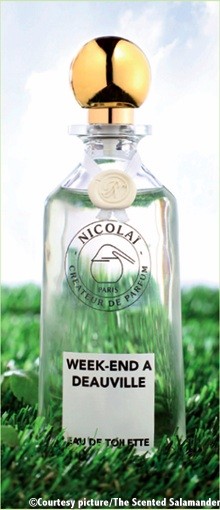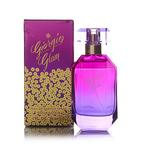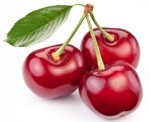Parfums de Nicolaï Weekend à Deauville (2011) Moody Muguet {Fragrance Review}

A quality I particularly appreciate about Parfums de Nicolaï fragrances is their capacity to exude a vieille-France character in a sea of modern, up-to-date perfumes. If you want to get away from the sinking feeling that too many releases have decided to borrow something pink from Christine Nagel's and Francis Kurkdjian's Musc for Her by Narciso Rodriguez, head for one of the several de Nicolaï boutiques in Paris, London or more conveniently, on the Internet.
How does perfumer Patricia de Nicolaï do it? This independent woman perfumer holds on tenaciously to some olfactory atmospheres that are the trademark seals of perfumed Frenchness. In her scents, you can expect to find complex, somewhat dark ambiances and that indispensable touch of musty oakmoss that signals that you are in real-woman territory, the one that does want to draw a clear-cut line with pretty, nubile fragrances. Her penultimate recent release, Kiss Me Tender, is the epitome of the Parisian woman who has gone through the harsh realities of WWII and survived to affirm her style. I should perhaps start chronologically with Kiss Me Tender which struck me most clearly with this welcome aloofness to trends, but here I am today with the latest iteration of Weekend à Deauville. And it's also the first of May or Muguet Day...
Weekend à Deauville is a composition which was first released in 2009 (review here) as a limited-edition and reworked in 2011 to incorporate more of the forbidden effects that create the note of muguet or lily of the valley. My memory of the first Weekend à Deauville is that of an elegant chypre with an artisanal tweak of imperfection. The new Weekend à Deauville retains the character of a chypre - another genre requested by higher instances to evolve in order to survive - but seems both darker and springier thanks to the muguet accord. There is a sort of light and shadow effect at play here which wants to paint the muguet black and give it a more smoldering intonation.
I think that it is interesting to draw some parallels with the Van Cleef and Arpels contributions to muguet in perfumery in the last couple of years. Their Muguet Blanc by Antoine Maisondieu is a pure soliflore of the flower. Then there is the masculine Midnight in Paris which explicitly wanted to create the effect of a dead-of-the-night lily of the valley suited for roaming nocturnal adventures.
With Weekend à Deauville 2, we see both a will to pay homage to the flower and a sudden nocturnal quality which was absent from the first version. The somber mood might also be due to the pessimism that Patricia de Nicolaï has let through regarding the increasingly constraining industrial regulations on the usage of crucial materials to the art of perfumery, and in particular here Lilial, Lyral Hydroxycitronellal.
While the perfumer's voice pegs the composition as a green floral, which it is -- the dark character of the composition rests in part on galbanum, besides leather and cedar wood - it is also in a more impressionistic sense, a somber, moody muguet.
For aficions, be it known that the lily of the valley accord by Patricia de Nicolaï is the child of jasmine absolute, ylang ylang supreme and galbanum resin. The geographic source of inspiration is not mere pretext as the region of Normandy is evoked here thanks to a slightly off-beat apple-cardamom accord, which smells of something approaching horseradish and Calvados liqueur. This is no candied, Disneyland apple scent but the one you might find in the breath of an English lad traipsing in the horse stables in Deauville. It reminds you of the pastoral streak in Patricia de Nicoiaï perfumes, provided it's not too far away from La Vie de Château.
If you would like to meditate on the perfume of apples, you can compare it with the accord created by Jean-Claude Ellena in Un Jardin sur le Toit. And if you are nice, I will tell you about my little adventure tasting a species of apple dating back to the Middle Ages.
For Normandy nostalgics, and besides apple, Helional and Calone were inserted to give a hint of the coastal air of the region; the leather is here to pay homage to the equestrian tradition of Deauville. The array of green notes -- peppermint, sweet basil, tarragon, galbanum, cardamom -- recalls how much the perfumer seems to have an innate inclination for sap-rich green fragrances. Her Le Temps d'une Fête is another noteworthy example of this predilection.
Muguet addicts will not find here the most straightforward and frank interpretation of the note. It is however one of the most sophisticated ones, like a lily of the valley which would have discarded its white organza skirts to done cool black velvet for the evening. On a practical plane, you could be interested in this perfume as an evening muguet scent. It is warm, slightly sweet, mossy, resinous, and last but not least, mysterious (because it is hidden), a quality not usually advertized by the (falsely) innocent scent of muguet. The perfume remains lady-like or gentleman-like, refusing to play upon the historical tradition of muguet as another name for musk and overpowering sexualized perfumed bait, a direction the ultra famous Diorissimo did take with its more primal (yet undertstated) musky power of attraction. If we know that human fertilization is encouraged by the scent of muguet-smelling ovules, this is one perfume that drapes this raw jungle fact with several layers of sophistication.
For other reviews of and essays on Muguet Perfumes see: Guerlain Le Muguet; Penhaligon's Lily of the Valley; Etat Libre d'Orange Dont' Get Me Wrong Baby, I Don't Swallow









